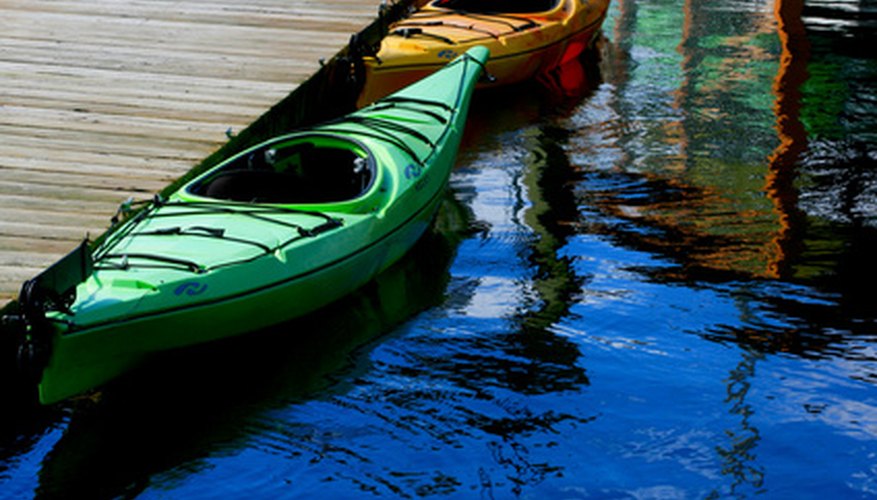Mildew is the early growth stage for mould and it forms as a result of moisture and water exposure. Mildew can form on many types of surfaces, including wood, paper, fabric, greenery and food, as well as fibreglass and plastics. Boats are particularly susceptible to mildew as a result of their constant exposure to moist conditions, in addition to poor storage.
Make sure the kayak is fully inflated.
Add a few squirts of dish soap to a large bucket. Fill the bucket with warm water.
Dip a sponge in the bucket, letting it absorb as much water and soap as possible. Wring out the sponge over the bucket.
- Mildew is the early growth stage for mould and it forms as a result of moisture and water exposure.
- Dip a sponge in the bucket, letting it absorb as much water and soap as possible.
Wipe off the entire surface of the kayak with the sponge, including the top, sides, bottom and inside (including the skirt). As soon as the sponge gets dirty or contaminated, dip it back in the bucket. Slosh the sponge in the water and wring it out several times each time. Change the warm water and soapy mixture halfway through this process to ensure you are not using contaminated water.
Clean the bucket using a hose and water until the soap residue has disappeared.
- Wipe off the entire surface of the kayak with the sponge, including the top, sides, bottom and inside (including the skirt).
- Clean the bucket using a hose and water until the soap residue has disappeared.
Refill the bucket with warm water.
Dip a new, clean sponge into the warm water and wipe any remaining soap or dirt off the kayak. As soon as the sponge gets dirty or contaminated, dip it back in the water to rinse it out again. Discard the water when you are finished.
Deflate the kayak by opening any of the inflating plugs.
Refill the bucket with two squirts of dishwashing liquid and warm water. If the first sponge isn't too dirty, dip it in the bucket and wring it out twice. If the first sponge is dirty, use a new sponge.
Wipe over any areas in the kayak that you couldn't reach when it was inflated. As soon as the sponge gets dirty or contaminated, dip it back in the water and soap.
Clean out the bucket one final time and refill it with warm water only. Using the second sponge, wipe over all areas of the kayak, including the recently cleaned hard to reach places, to remove any soap or dirt.
- Deflate the kayak by opening any of the inflating plugs.
- Using the second sponge, wipe over all areas of the kayak, including the recently cleaned hard to reach places, to remove any soap or dirt.
Pick up the deflated kayak and shake it out to remove any excess water.
Lay the kayak out on a non-humid day to let it dry out for an hour or so. If the kayak is not entirely dry, use clean rags to wipe off any water before storing the boat.
Unfold and construct the kayak, if needed. Mix of one part white vinegar to one part warm water in a clean bucket.
Dip a scrub brush in the bucket and slosh it around so that it is well saturated.
- Pick up the deflated kayak and shake it out to remove any excess water.
- Dip a scrub brush in the bucket and slosh it around so that it is well saturated.
Scrub all parts of the wooden frame of the kayak with the vinegar and water mixture to remove any mildew. Repeat this step twice.
Let the wooden frame dry out after you scrub it (for 1 to 2 hours).
Lightly sand the entire wooden frame with 240 or higher grit sandpaper to remove any final traces of mildew. Wipe the wooden frame with a dampened rag (with water) to remove the sawdust.
- Let the wooden frame dry out after you scrub it (for 1 to 2 hours).
- Wipe the wooden frame with a dampened rag (with water) to remove the sawdust.
Fill a bucket with warm water and a few squirts of dish soap. Dip the sponge into the mixture to completely wet it and then wring it out twice.
Wipe over the entire surface of the foldable kayak skin with the sponge. Repeat this process as many times as necessary to remove mildew or dirt.
Rinse off the kayak skin with a hose to get all of the soap off. Turn over the foldable kayak to get rid of any trapped and excess water.
Wipe the entire kayak dry with a clean rag and then leave it a partly shaded place to completely dry out before you store it.
WARNING
Do not leave an inflatable kayak in the direct sunlight for too long if you are drying it out. Instead, place the kayak in a partly sunlit area.
